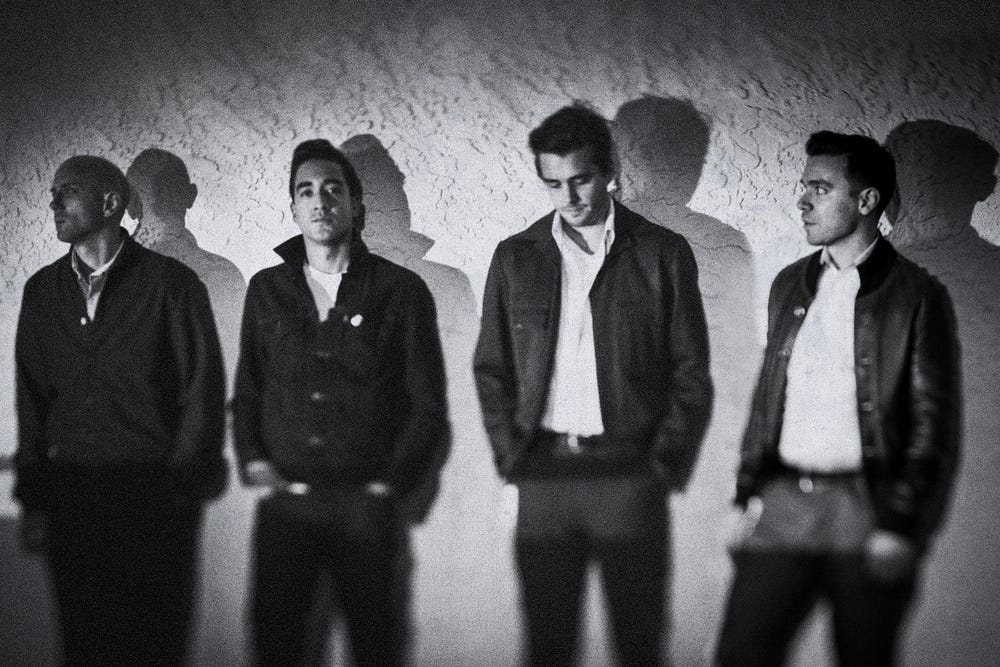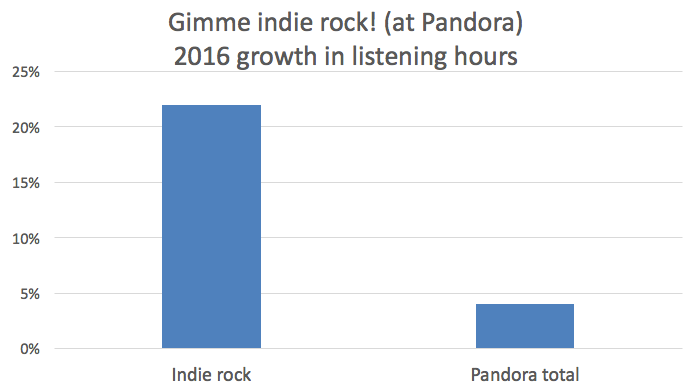Indie Rock Is Thriving On Pandora
[UPDATED] The state of indie rock? Always up for debate. The state of indie rock at Pandora? Never been better, says the music streamer's Glenn Peoples, who took a deep dive into the data.
______________________________________
By Glenn Peoples, Music Insights and Analytics at Pandora
Lord Huron, a folky four-piece that weaves rural tradition into the skinny-jeaned sounds of urban America, makes for an excellent example of the state of indie rock at Pandora. The Los Angeles-based band is part of the burgeoning indie folk scene and has quietly surpassed 100 million spins . Indie folk, accented by Appalachian and other rural traditions, and typically released on rock-focused labels, has a Pandora station—the aptly named Indie Folk Revival—with over one million followers. It’s one of a few dozen sub-genres filed under the growing indie rock genus, giving myriad less-than-household names impressively outsized numbers of spins.

At Pandora, indie rock’s variety is a virtue.
“Indie is very fragmented,” explains Crystal Lowe, head of indie and alternative programming Pandora. “The way the younger generation listens to music is scattered.”
For a visible example, look at the posters of summer music festivals, effectively indie rock eye charts with dozens of performers crammed onto a page. A poster’s pecking order — a few headliners on top, 100 or so working-class artists in the middle, and baby bands at the bottom — is an allegory for the diverse nature of indie rock. Not only are handfuls of musical niches represented, but fans also aren’t content to hear just a few artists. Whether a festival lineup or an Internet radio station, diversity is the common thread.
As a whole, indie rock has arguably never performed better at Pandora. Last year, indie rock listening hours were up 22 percent, 18 points better than the company-wide increase of four percent. More people listened to indie, too. From the beginning of 2015 to the end of 2016, the number of indie music listeners grew 141 percent.
Wondering if indie rock dead (or dying), artists, pundits, and critics have fretted that chart-topping artists in mainstream genres are releasing the better, most progressive music. Indeed, few the indie world’s spotlight-shunning artists are achieving the strong sales of their counterparts in hip-hop, R&B, pop and country. Purposeful deviations from pop music have undersold major acts for decades, from the post-punk of the 70s to jangly college rock of the 80s, and then low-fi, guitar-driven, and slightly disheveled rock of the ’90s (Sebadoh’s single “Gimme Indie Rock” was released in 1991).
But indie music can boast of a huge membership. By the end of the 00s, the crush of guitar-based indie music had given birth to an unflattering term, indie landfill. The ascendance of EDM — think Avicii, not Justice — is surely a strong magnet in the 10s, but rock tradition is still a siren song. The Indie Folk Revival station (1.3 million listeners) encapsulates the broader popularity of indie at Pandora. From mid-April to the second week of September, the stations’ average time spent listening increased a healthy 16 percent.
“Folk-based music is definitely on the rise, stemming from the explosion of folk-influenced bands like Mumford & Sons and Vance Joy, and The Lumineers incorporating instruments like the banjo and mandolin into their sound,” explains Lowe.

The rising tide is lifting many boats. With the help of the Indie Folk Revival and Indie Singer Songwriters station (1.5 million listeners), and alongside indie mainstays Bon Iver and Iron & Wine, less familiar names have gathered a surprising number of spins. Gregory Alan Isakov, Radical Face, and Peter Bradley Adams each has a Pandora spin count in the hundreds of millions. Isakov benefits from three famous artists in particular: other than his artist stations (Pandora stations created with Isakov as the seed), Isakov gets the majority of his spins from Mumford & Sons, The Lumineers, and Bon Iver stations. Lord Huron’s spins picked up speed in April after the song “The Night We Met” was used in a March 31st episode of the Netflix series “13 Reasons Why.” Broadcast radio picked up the song but the listening audience started to fade fewer than three months later. In the meantime, Lord Huron’s Pandora daily spins have continued to rise to this day — exactly what you would expect from a rising artist in a burgeoning genre.
Outside of Pandora the story diverges, however. Last year, U.S. consumption of indie music lagged behind other genres by two key measures: album consumption and song consumption. Indie rock albums were down one percent versus an industry-wide gain of five-percent, according to BuzzAngle. (Album consumption is a combination of album sales, track sales and on-demand streams. BuzzAngle has eight indie sub-categories including indie rock, Britpop, post-punk, and art & experimental. It does not include indie dance, a sub-category Pandora puts within indie rock.) In addition, song consumption of indie rock (measured as track purchases plus streams), grew 23 percent, four points behind the overall market’s 27-percent gain. Mainstream genres fared better. For album consumption, dance exploded with a 35-percent gain, hip-hop grew 25 percent, and R&B rose 24 percent. Country lagged but posted a positive 5-percent gain. Dance led all genres in song consumption with a 75-percent gain while hip-hop grew 62 percent.
A Reddit user once provided a viable definition of indie rock: it’s “really just Pitchfork/culture-approved music that (typically) doesn’t break into the top 40,” referencing the tastemaker website and festival organizer. Indeed, the top 40 is rarely visited by indie rock tracks. “Feel It Still” by Portugal. The Man, an indie rock band from Alaska, entered Pandora’s top 10 tracks but is more of an outlier than part of a trend. The top 100 is a pop- and hip-hop-heavy list with nothing else that qualifies as indie rock. The Billboard singles chart is more bereft of indie rock. Twenty one pilots might qualify if not for success, and Coldplay, now a hybrid of dance, pop, and rock, would have counted ten or 15 years ago. Indie rock, like rock in general, still clings to the album format, and indie sightings are common on the Billboard 200 album chart. Stretch its definition and indie rock landed a few albums on the list of 2016’s top 100: Panic! At The Disco, The Lumineers, Radiohead, and The 1975. As an aside, the Wikipedia pages of The 1975 and twenty one pilots peg them as indie rock and indie pop, respectively, and The Lumineers carry the indie folk tag.
But, again, indie rock is surging at Pandora. Pandora’s 31 indie channels cover a combination of well known – The Stooges on the Garage Rock station—and under-the-radar artists that shun the trappings of successful music. The Indie Dance station will follow beloved indie groups like Phoenix and Gorillaz with less known acts Ghostland Observatory and STRFCKR. The Dream Pop station deftly mixes decades of shimmering rock songs: The Jesus and Mary Chain’s “Sometimes Always” (with the supple voice of Hope Sandoval of Mazzy Star), Beach House’s “Wild,” and Cocteau Twins’ “Lorelei,” for example. The Strokes, The Shins, and Peter Bjorn and John are mainstays on the Classic Indie Rock station, a hipster version of the familiar AM/FM format.
The term indie landfill is snarky but silly. Digital radio is like attending the Bonnaroo Music and Arts Festival, the indie-filled, four-day gathering in Middle Tennessee: people hear the familiar, sample the unfamiliar, and, if feeling game, go spelunking through the depths of dream pop, the sounds of the Silverlake neighborhood in Los Angeles, jarring post-punk, or sad indie (Pandora’s got a station for that last one). Variety…Such a virtue.